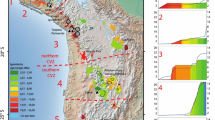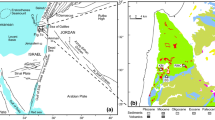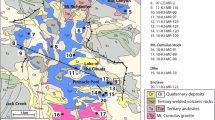Abstract
Isotopic and trace element data from mantle and granulite xenoliths are used to estimate the relative contributions of mantle and crustal components to a large ignimbrite, referred to as the upper ignimbrite, that is representative of the voluminous mid-Cenozoic rhyolites of northwestern Mexico. The study also uses data from the volcanic rocks to identify deep crustal xenoliths that are samples of new crust created by the Tertiary magmatism. The isotopic composition of the mantle component is defined by mantle-derived pyroxenites that are interpreted to have precipitated from mid-Cenozoic basaltic magmas. This component has ɛNd≈+1.5, 87Sr/86Sr≈0.7043 and 206Pb/204Pb≈18.6. Within the upper ignimbrite and associated andesitic and dacitic lavas, initial 87Sr/86Sr is positively correlated with SiO2, reaching 0.7164 in the ignimbrite. Initial 206Pb/204Pb ratios also show a positive correlation with silica, whereas ɛNd values have a crude negative correlation, reaching values as low as −2. Of the four isotopically distinct crustal components identified from studies of granulite xenoliths, only the sedimentary protolith of the paragneiss xenoliths can be responsible for the high initial 87Sr/86Sr of the upper ignimbrite. The Nd, Sr, and Pb isotopic compositions of the upper ignimbrite can be modeled with relatively modest assimilation (≤20%) of the sedimentary component ± Proterozoic granulite. Gabbroic composition granulite xenoliths have distinctive Nd, Sr, and Pb isotope ratios that cluster closely within the range of compositions found in the andesitic and dacitic lavas. These mafic granulites are cumulates, and their protoliths are interpreted to have precipitated from the intermediate to silicic magmas at 32–31 Ma. These mafic cumulate rocks are probably representative of much of the deep crust that formed during mid-Cenozoic magmatism in Mexico. Worldwide xenolith studies suggest that the relatively great depth (≤20 km) at which assimilation-fractional crystallization took place in the intermediate to silicic magma systems of the La Olivina region is the rule rather than the exception. Oligocene ignimbrites of the southwestern United States (SWUS) have substantially lower ɛNd values (e.g. <−6) than the upper ignimbrite and other rhyolites from Mexico. This difference appears to reflect a greater crustal contribution to ignimbrites of the SWUS, perhaps due to a higher temperature of the lower crust prior to the emplacement of the Oligocene basaltic magmas.
Similar content being viewed by others
Author information
Authors and Affiliations
Additional information
Received: 16 December 1994 / Accepted: 13 September 1995
Rights and permissions
About this article
Cite this article
Smith, R., Cameron, K., McDowell, F. et al. Generation of voluminous silicic magmas and formation of mid-Cenozoic crust beneath north-central Mexico: evidence from ignimbrites, associated lavas, deep crustal granulites, and mantle pyroxenites. Contrib Mineral Petrol 123, 375–389 (1996). https://doi.org/10.1007/s004100050163
Issue Date:
DOI: https://doi.org/10.1007/s004100050163




